Exploring the Dominant Runoff Processes in Two Typical Basins of the Yellow River, China
Abstract
1. Introduction
2. Materials and Methods
2.1. Study Area
2.2. Data Collection
2.2.1. Hydro-Meteorological Data
2.2.2. Spatial Data
2.3. Methods
2.3.1. Runoff Division
2.3.2. Antecedent Precipitation Index
2.3.3. Determination of the Dominant Runoff Process
3. Results and Discussion
3.1. Changes in Runoff Composition Trends
3.2. Spatial Distribution of DRP
3.3. DRP Maps and Runoff Compositions
3.4. DRP Maps’ Reaction to Flood Process
4. Conclusions
Author Contributions
Funding
Acknowledgments
Conflicts of Interest
References
- Wei, Y.; Jiao, J.; Zhao, G.; Zhao, H.; He, Z.; Mu, X. Spatial-Temporal Variation and Periodic Change in Streamflow and Suspended Sediment Discharge Along the Main-Stream of the Yellow River During 1950–2013. Catena 2016, 140, 105–115. [Google Scholar] [CrossRef]
- Wang, G.; Cheng, G. The Characteristics of Water Resources and the Changes of the Hydrological Process and Environment in the Arid Zone of Northwest China. Environ. Geol. 2000, 39, 783–790. [Google Scholar] [CrossRef]
- Zhang, Y.; Ma, J.; Chang, X.; Van Wonderen, J.; Yan, L.; Han, J. Water Resources Assessment in the Minqin Basin: An Arid Inland River Basin Under Intensive Irrigation in Northwest China. Environ. Earth Sci. 2011, 65, 1831–1839. [Google Scholar] [CrossRef]
- Chen, Y.; Xu, C.; Chen, Y.; Liu, Y.; Li, W. Progress, Challenges and Prospects of Ecohydrological Studies in the Tarim Riverbasin of Xinjiang China. Environ. Manag. 2013, 51, 138–153. [Google Scholar] [CrossRef]
- Gao, P.; Zhang, X.; Mu, X.; Wang, F.; Li, R.; Zhang, X. Trend and Change-Point Analyses of Streamflow and Sediment Discharge in the Yellow River During 1950–2005. Hydrol. Sci. J. 2010, 55, 275–285. [Google Scholar] [CrossRef]
- Miao, C.; Ni, J.; Borthwick, A.G.L. Recent Changes of Water Discharge and Sediment Load in the Yellow River Basin, China. Prog. Phys. Geogr. 2010, 34, 541–561. [Google Scholar] [CrossRef]
- Yang, S.; Kang, T.; Bu, J.; Chen, J.; Gao, Y. Evaluating the Impacts of Climate Change and Vegetation Restoration on the Hydrological Cycle over the Loess Plateau, China. Water 2019, 11, 2241. [Google Scholar] [CrossRef]
- Gao, P.; Mu, X.-M.; Wang, F.; Liu, T. Changes in Streamflow and Sediment Discharge and the Response to Human Activities in the Middle Reaches of the Yellow River. Hydrol. Earth Syst. Sci. 2011, 15, 1–10. [Google Scholar] [CrossRef]
- Jiang, T.; Fischer, T.; Lu, X. Larger Asian Rivers: Climate Change, River Flow, and Watershed Management. Quat. Int. 2010, 226, 1–3. [Google Scholar] [CrossRef]
- Liu, J.; Luo, M.; Liu, T.; Bao, A.; De Maeyer, P.; Feng, X.; Xi, C. Local Climate Change and the Impacts on Hydrological Processes in an Arid Alpine Catchment in Karakoram. Water 2017, 9, 344. [Google Scholar] [CrossRef]
- Farsi, N.; Mahjouri, N. Evaluating the Contribution of the Climate Change and Human Activities to Runoff Change Under Uncertainty. J. Hydrol. 2019, 574, 872–891. [Google Scholar] [CrossRef]
- Yin, J.; He, F.; Xiong, Y.J.; Qiu, G.Y. Effects of Land Use/Land Cover and Climate Changes on Surface Runoff in a Semi-Humid and Semi-Arid Transition Zone in Northwest China. Hydrol. Earth Syst. Sci. 2017, 21, 183–196. [Google Scholar] [CrossRef]
- Zhao, Y.L.; Wang, Y.Q. Distribution Characteristics of Bulk Density and Saturated Hydraulic Conductivity in Intensive Land Restoration Project Areas on the Loess Plateau. Trans. Chin. Soc. Agric. Eng. 2020, 36, 83–90. [Google Scholar]
- Chen, X.; Yang, J.; Tang, C.; Zheng, T.; Li, L. Effect Rainfall Intensity and Slope on Surface and Subsurface Runoff in Red Soil Slope Farmland. Trans. Chin. Soc. Agric. Eng. 2017, 33, 141–147. [Google Scholar]
- Müller, C.; Hellebrand, H.; Seeger, M.; Schobel, S. Identification and Regionalization of Dominant Runoff Processes–A GIS-Based and a Statistical Approach. Hydrol. Earth Syst. Sci. 2009, 13, 779–792. [Google Scholar] [CrossRef]
- Hümann, M.; Muller, C. Improving the GIS-DRP Approach by Means of Delineating Runoff Characteristics with New Discharge Relevant Parameters. ISPRS Int. J. Geo-Inf. 2013, 2, 27–49. [Google Scholar] [CrossRef]
- Ferreira, C.; Keizer, J.; Santos, L.; Serpa, D.; Silva, V.; Cerqueira, M.; Ferreira, A.J.D.; Abrantes, N. Runoff, Sediment and Nutrient Exports From a Mediterranean Vineyard Under Integrated Production: An Experiment at Plot Scale. Agric. Ecosyst. Environ. 2018, 256, 184–193. [Google Scholar] [CrossRef]
- Naef, F.; Scherrer, S.; Weiler, M. A Process Based Assessment of the Potential to Reduce Flood Runoff by Land Use Change. J. Hydrol. 2002, 267, 74–79. [Google Scholar] [CrossRef]
- Scherrer, S.; Naef, F. A Decision Scheme to Indicate Dominant Hydrological Flow Processes on Temperate Grassland. Hydrol. Process. 2003, 17, 391–401. [Google Scholar] [CrossRef]
- Antonetti, M.; Buss, R.; Scherrer, S.; Margreth, M.; Zappa, M. Mapping Dominant Runoff Processes: An Evaluation of Different Approaches Using Similarity Measures and Synthetic Runoff Simulations. Hydrol. Earth Syst. Sci. 2016, 20, 2929–2945. [Google Scholar] [CrossRef]
- Kong, D.; Miao, C.; Wu, J.; Duan, Q.-Y. Impact Assessment of Climate Change and Human Activities on Net Runoff in the Yellow River Basin from 1951 to 2012. Ecol. Eng. 2016, 91, 566–573. [Google Scholar] [CrossRef]
- Zuo, D.; Xu, Z.; Yao, W.; Jin, S.; Xiao, P.; Ran, D. Assessing the Effects of Changes in Land Use and Climate on Runoff and Sediment Yields From a Watershed in the Loess Plateau of China. Sci. Total Environ. 2016, 544, 238–250. [Google Scholar] [CrossRef] [PubMed]
- Data of the Yellow River Basin. Available online: http://www.yrcc.gov.cn/ (accessed on 15 September 2020).
- Dijkshoorn, J.A.; van Engelen, V.W.P.; Hunting, J.H. Soil and Landform Properties for LADA Partner Countries (Argentina, China, Cuba, Senegal and the Gambia, South Africa and Tunisia). GLADA Report 2. 2008. Available online: http://www.isric.org/isric/Webdocs/Docs/ISRIC_Report (accessed on 29 October 2020).
- Xu, L.-L.; Liu, J.-L.; Jin, C.; Wang, A.; Guan, D.; Wu, J.-B.; Yuan, F. Baseflow Separation Methods in Hydrological Process Research: A Review. Chin. J. Appl. Ecol. 2011, 22, 3073–3080. [Google Scholar]
- Barthold, F.K.; Woods, R.A. Stormflow Generation: A Meta-Analysis of Field Evidence from Small, Forested Catchments. Water Resour. Res. 2015, 51, 3730–3753. [Google Scholar] [CrossRef]
- Chow, V.T. Bibliography: Handbook of Applied Hydrology. Hydrol. Sci. J. 1965, 10, 82–83. [Google Scholar] [CrossRef]
- Dunne, T.; Black, R.D. Partial Area Contributions to Storm Runoff in a Small New England Watershed. J. Water Resour. Res. 1970, 6, 1296–1311. [Google Scholar] [CrossRef]
- Walhin, J.F.; Paris, J. Recursive Formulae for Some Bivariate Counting Distributions Obtained by the Trivariate Reduction Method. ASTIN Bull. 2000, 30, 141–155. [Google Scholar] [CrossRef]
- Schmocker-Fackel, P. A Method to Delineate Runoff Processes in a Catchment and Its Implications for Runoff Simulations. Master’s Thesis, ETH Zurich, Zurich, Switzerland, 2004. [Google Scholar]
- Li, G.F.; Zheng, F.L. Effects of Rainfall and Topography on Soil Erosion Processes of Black Soil Hillslope. Trans. Chin. Soc. Agric. Mach. 2015, 46, 147–153. [Google Scholar]
- Zheng, Z.C.; Qin, F.; Li, T.X. Changes in Soil Surface Microrelief of Purple Soil Under Different Slope Gradients and Its Effects on Soil Erosion. Trans. Chin. Soc. Agric. Mach. 2015, 31, 168–176. [Google Scholar]
- Xin, Z.; Yu, X.-X. Impact of Vegetation Restoration on Hydrological Processes in the Middle Reaches of the Yellow River, China. For. Stud. China 2009, 11, 209–218. [Google Scholar] [CrossRef]
- Wen, Y.; Hu, C.; Zhang, G.; Jian, S. Response of the Parameters of Excess Infiltration and Excess Storage Model to Land Use Cover Change. J. Hydrol. Hydromech. 2020, 68, 99–110. [Google Scholar] [CrossRef]
- Minea, G.; Ioana-Toroimac, G.; Moroşanu, G. The Dominant Runoff Processes on Grassland Versus Bare Soil Hillslopes in a Temperate Environment—An Experimental Study. J. Hydrol. Hydromech. 2019, 67, 297–304. [Google Scholar] [CrossRef]
- Hu, C.H.; Ran, G.; Jian, S.Q. Effect of Forest and Grass Cover Change on Runoff Mechanism in Jialu River Basin. J. Soil Water Conserv. 2020, 34, 36–45. [Google Scholar]
- Hu, C.; Zhang, L.; Wu, Q.; Soomro, S.-E.-H.; Jian, S. Response of LUCC on Runoff Generation Process in Middle Yellow River Basin: The Gushanchuan Basin. Water 2020, 12, 1237. [Google Scholar] [CrossRef]
- Jiao, Y.; Lei, H.; Yang, D.; Huang, M.; Liu, D.; Yuan, X. Impact of Vegetation Dynamics on Hydrological Processes in a Semi-Arid Basin by Using a Land Surface-Hydrology Coupled Model. J. Hydrol. 2017, 551, 116–131. [Google Scholar] [CrossRef]
- Jia, X.X.; Zhao, M.A. Variation and Simulation of Soil Water Content Within Different Soil Depths Along the South-North Transect of the Loess Plateau. Adv. Water Sci. 2016, 27, 520–529. [Google Scholar]
- Schmocker-Fackel, P.; Naef, F.; Scherrer, S. Identifying Runoff Processes on the Plot and Catchment Scale. Hydrol. Earth Syst. Sci. 2007, 11, 891–906. [Google Scholar] [CrossRef]
- Scherrer, S.; Naef, F.; Faeh, A.O.; Cordery, I. Formation of Runoff at the Hillslope Scale During Intense Precipitation. Hydrol. Earth Syst. Sci. 2007, 11, 907–922. [Google Scholar] [CrossRef]
- Jing, L.; Li, J.P. Study on Dry Soil Layers Under Different Land-Use Systems in the Loess Plateau. Pratacultural Sci. 2018, 35, 1829–1835. [Google Scholar]
- Yi, X.B.; Jia, X.X. Egional Spatial and Seasonal Characteristics of Soil Desiccation on the Loess Plateau. Adv. Water Sci. 2017, 28, 373–382. [Google Scholar]
- Hao, Z.; Zheng, J.; Ge, Q.; Guo, X. Relationship Between Precipitation and the Infiltration Depth Over the Middle and Lower Reaches of the Yellow River and Yangtze-Huaihe River Valley. Prog. Nat. Sci. 2008, 18, 1123–1128. [Google Scholar] [CrossRef]
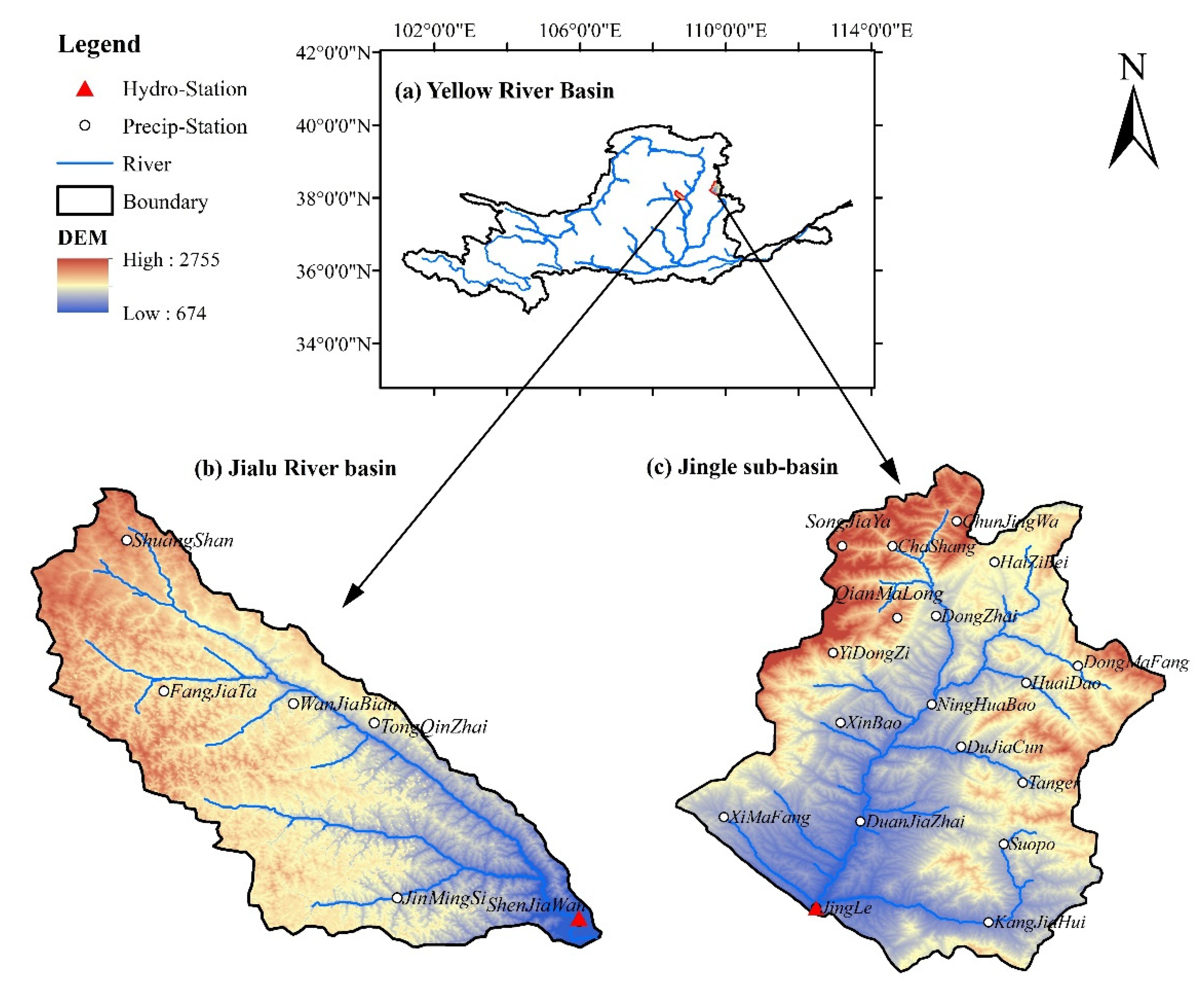
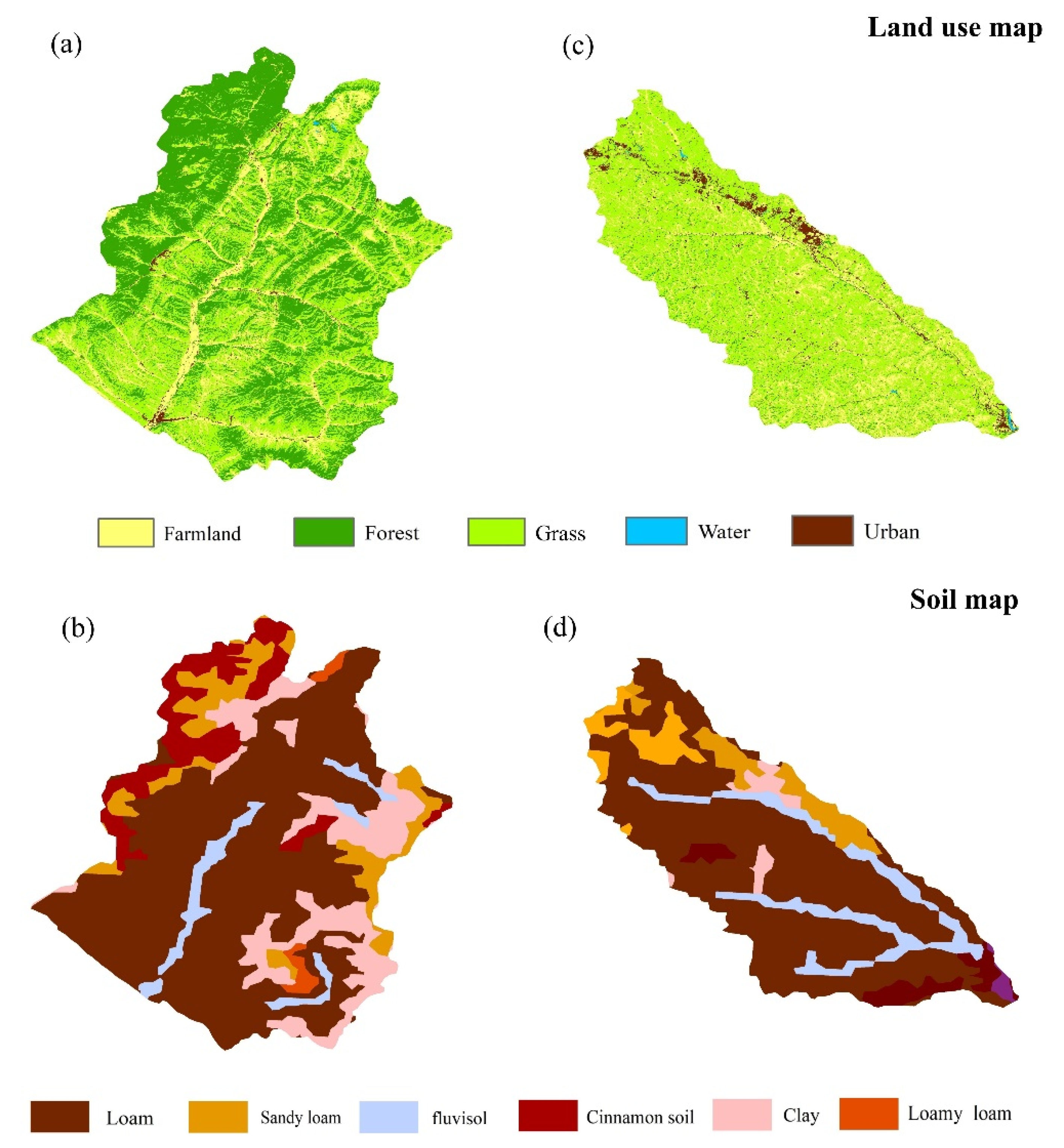
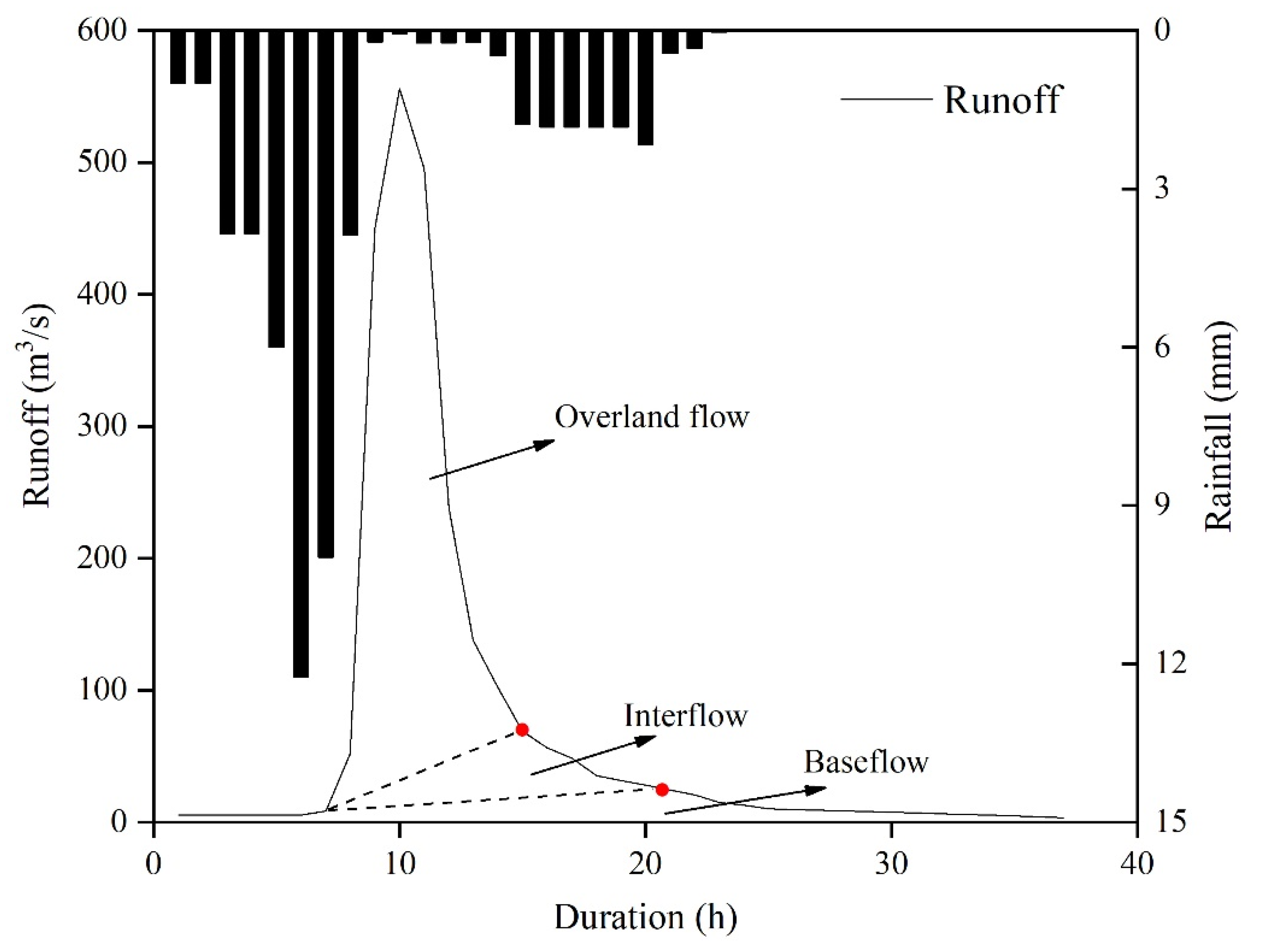
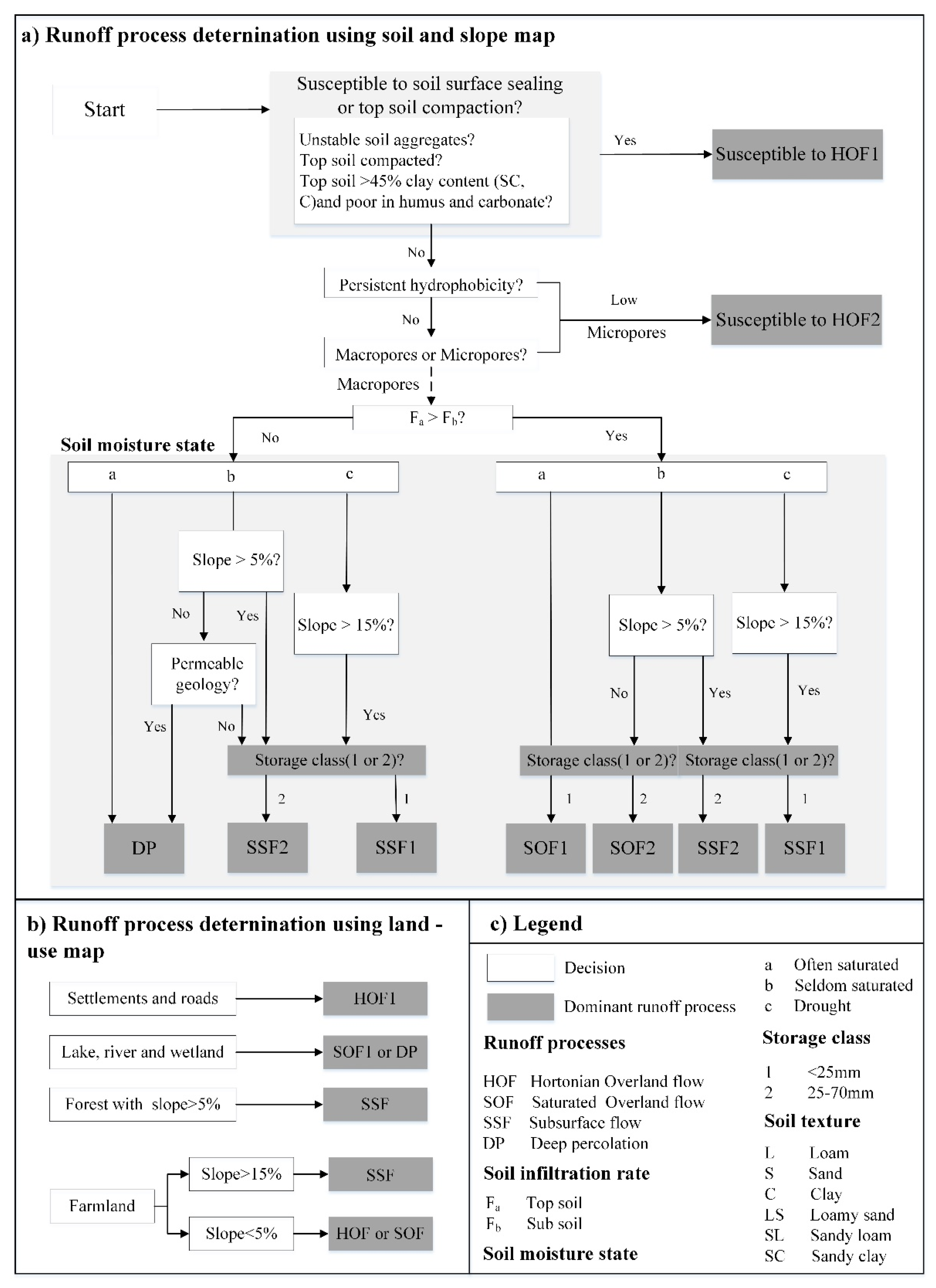
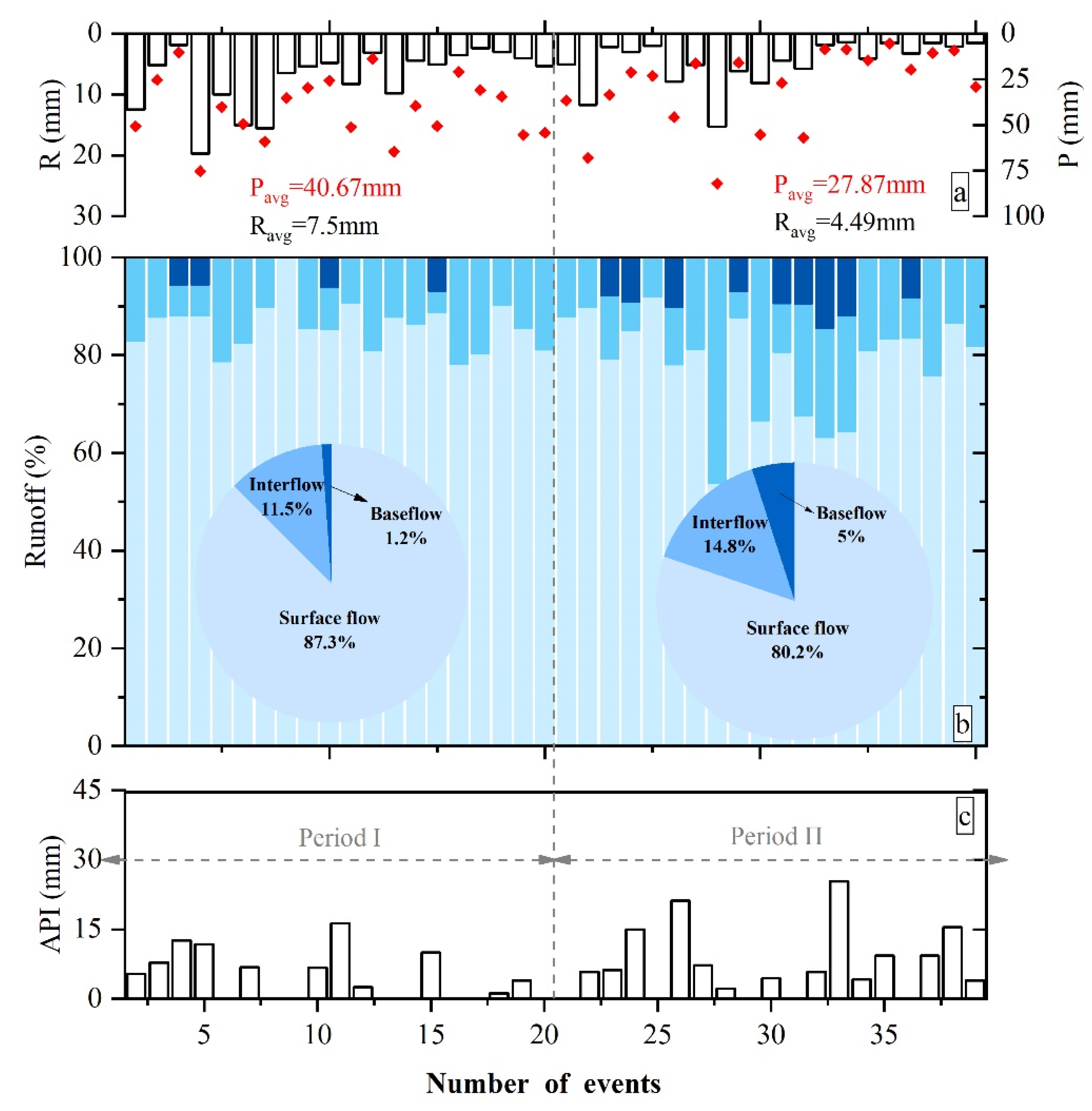
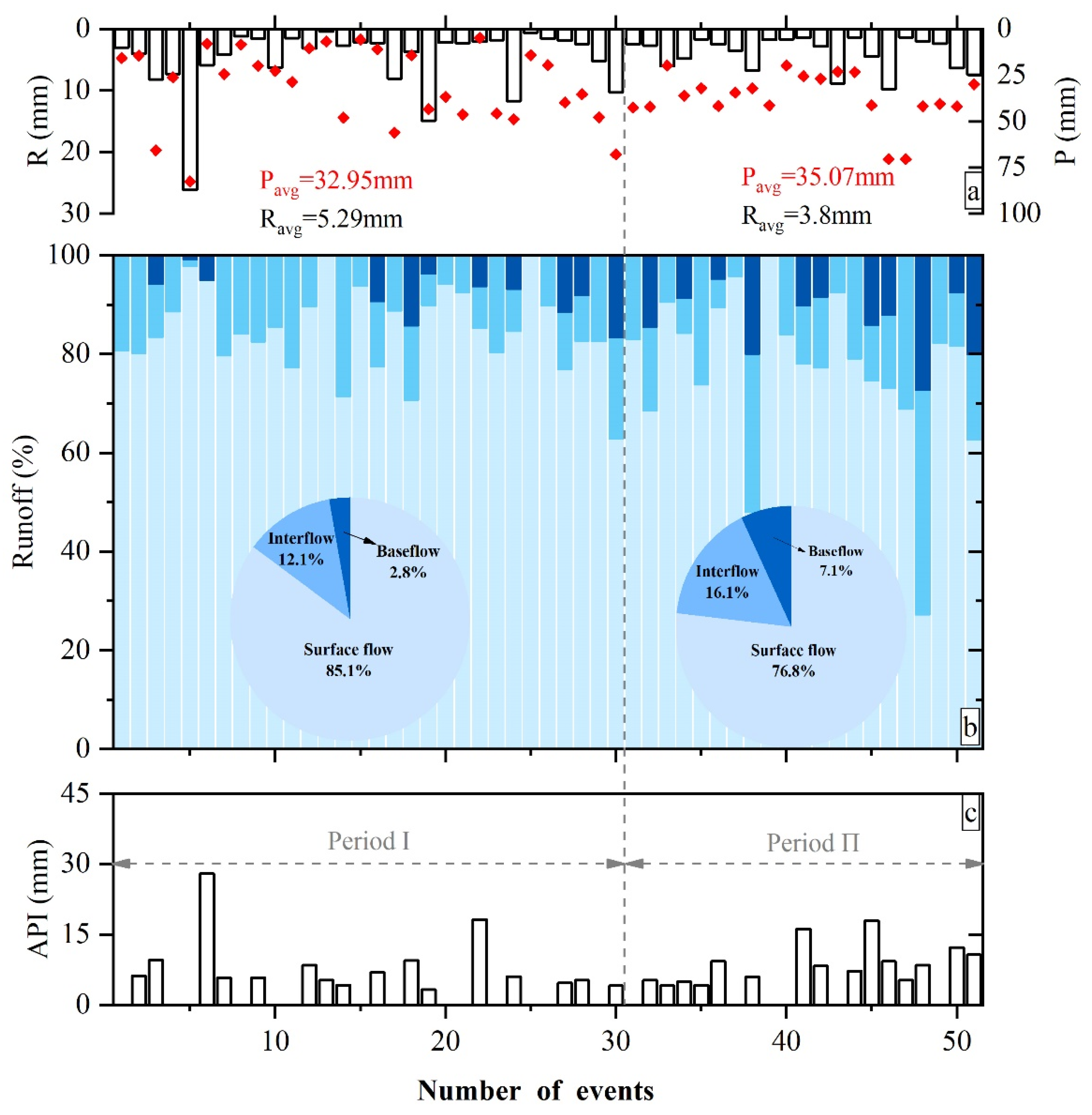
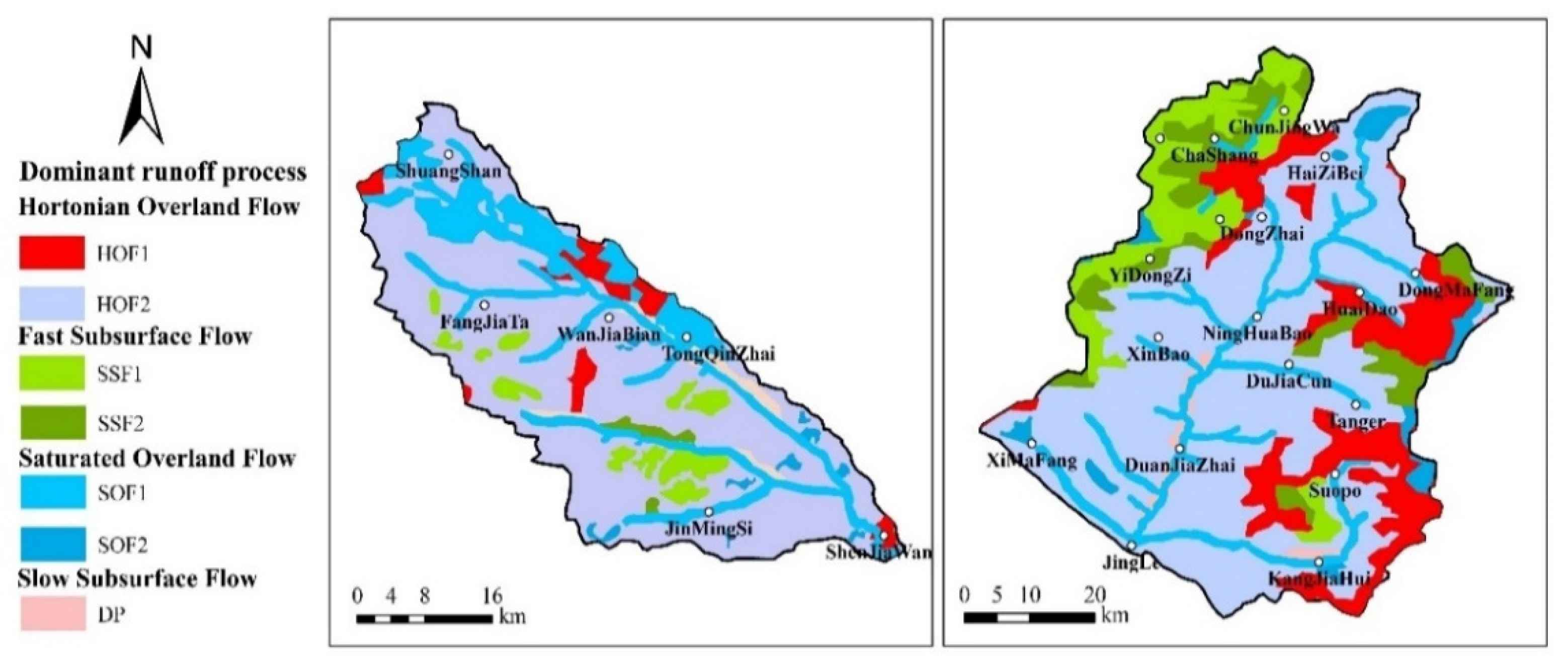
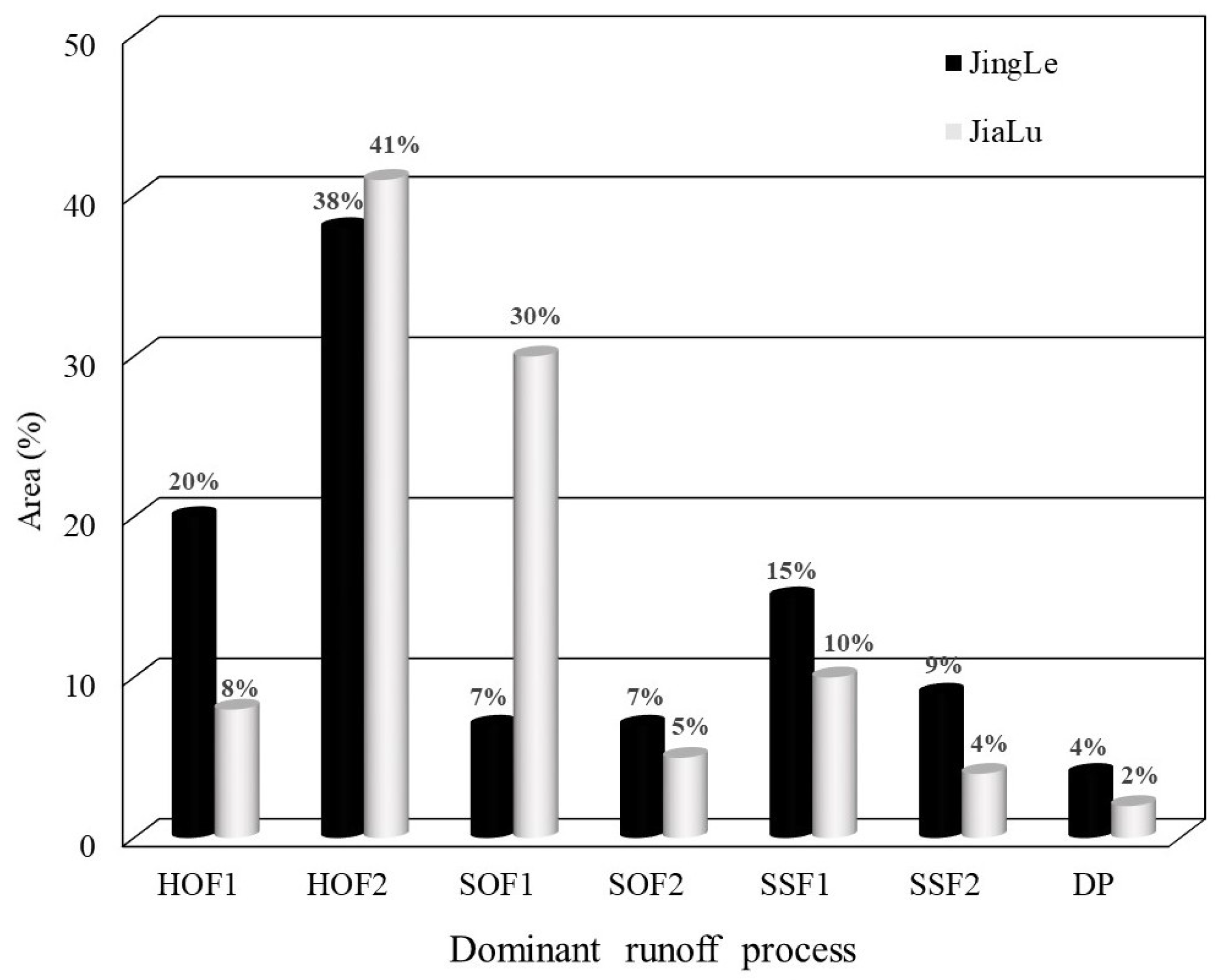
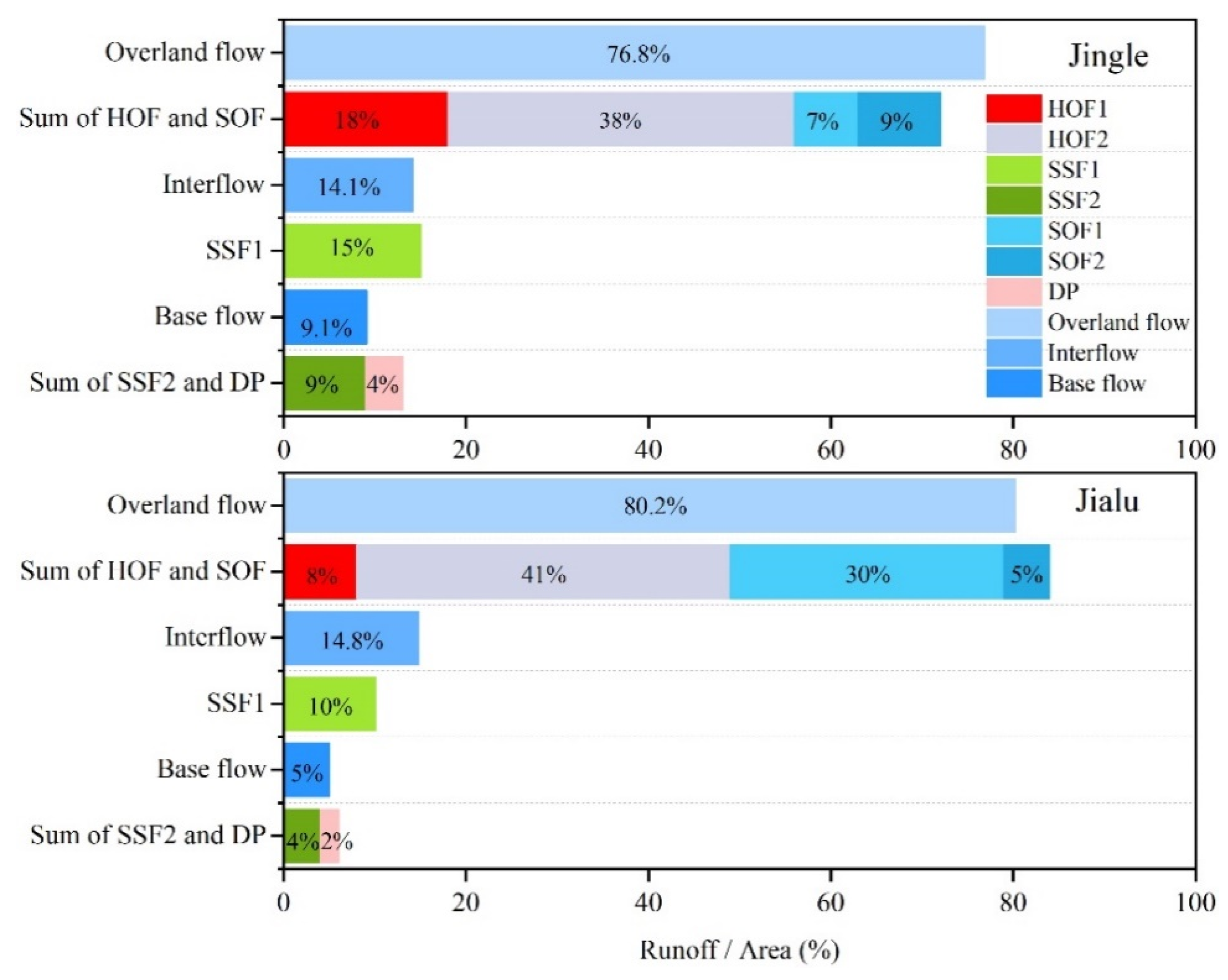
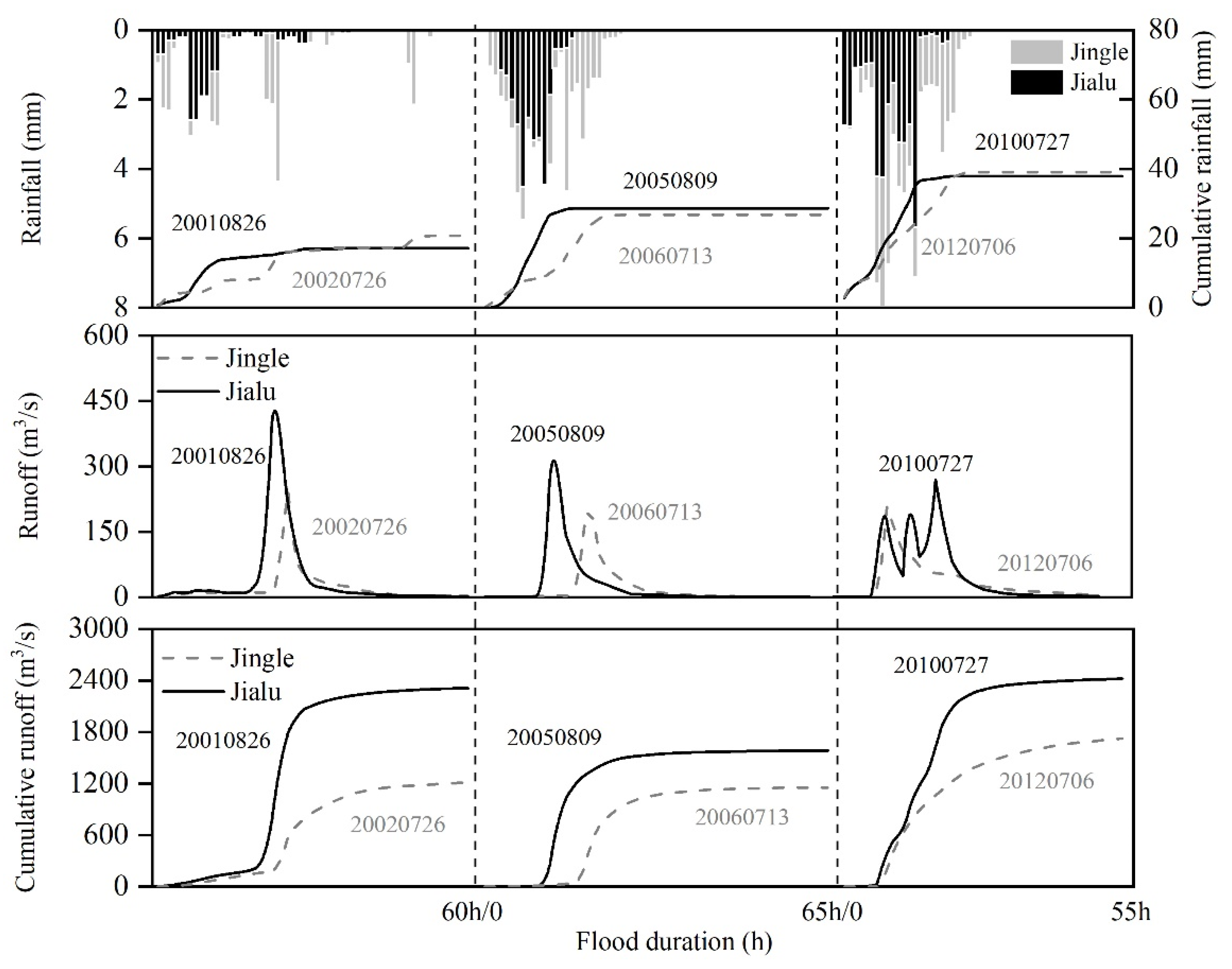
| Catchment | Area (km2) | Elevation Range (m) | Geology | Land Use of 2013(%) | ||||
|---|---|---|---|---|---|---|---|---|
| Farmland | Forest | Grass | Water | Urban | ||||
| Jialu River basin | 1134 | 674–1374 | Sandstone, limestone, alluvial rock | 40.5 | 20.73 | 38.5 | 0.14 | 0.13 |
| Jingle sub-basin | 2799 | 1194–2755 | Sandstone, shale, conglomerate | 25.3 | 15.85 | 58.6 | 0.08 | 0.17 |
| Resolution | Comments | Reference or Data Holder | |
|---|---|---|---|
| Soil map | - | Contains information about soil types | World Soil Database (FAO/IIASA/ISRIC2008) |
| Soil information map | - | Information about soil depth and soil water characteristics | Soil Science Database of China |
| Slope map | 30 m | Geospatial Date Cloud | |
| Land use map | 30 m | National Earth System Science Data Center (2013) | |
| Geological map | - | Stratigraphic units | World Soil Database (2008) |
| Process | Type | Abbreviation | Intensity of Runoff Process |
|---|---|---|---|
| Overland flow processes | Hortonian | HOF1 | Immediate Hortonian overland flow due to infiltration hindrance (infiltration excess overland flow) |
| HOF2 | Delayed Hortonian overland flow due to infiltration hindrance | ||
| Saturation | SOF1 | Immediate saturation overland flow due to soil saturation | |
| SOF2 | Delayed saturation overland flow due to soil saturation | ||
| Subsurface flow processes | Lateral flow | SSF1 | Subsurface flow |
| SSF2 | Delayed subsurface flow | ||
| Vertical flow | DP | Deep percolation |
| Group | Session | Precipitation (mm) | Rainfall Intensity (mm/h) | Floods Duration (h) | Peak Flow (m3/s) | Runoff (mm) |
|---|---|---|---|---|---|---|
| 1 | 20010816 | 25.5 | 0.52 | 59 | 582 | 6.5 |
| 20020726 | 26.93 | 0.75 | 63 | 254 | 3.29 | |
| 2 | 20050809 | 28.6 | 1.30 | 68 | 399 | 4.2 |
| 20060713 | 26.82 | 1.07 | 65 | 236.8 | 1.48 | |
| 3 | 20100727 | 45.8 | 2.29 | 53 | 275 | 7.85 |
| 20120706 | 47.84 | 1.91 | 55 | 194 | 5.22 |
Publisher’s Note: MDPI stays neutral with regard to jurisdictional claims in published maps and institutional affiliations. |
© 2020 by the authors. Licensee MDPI, Basel, Switzerland. This article is an open access article distributed under the terms and conditions of the Creative Commons Attribution (CC BY) license (http://creativecommons.org/licenses/by/4.0/).
Share and Cite
Ran, G.; Jian, S.; Wu, Q.; Zhang, L.; Hu, C. Exploring the Dominant Runoff Processes in Two Typical Basins of the Yellow River, China. Water 2020, 12, 3055. https://doi.org/10.3390/w12113055
Ran G, Jian S, Wu Q, Zhang L, Hu C. Exploring the Dominant Runoff Processes in Two Typical Basins of the Yellow River, China. Water. 2020; 12(11):3055. https://doi.org/10.3390/w12113055
Chicago/Turabian StyleRan, Guang, Shengqi Jian, Qiang Wu, Li Zhang, and Caihong Hu. 2020. "Exploring the Dominant Runoff Processes in Two Typical Basins of the Yellow River, China" Water 12, no. 11: 3055. https://doi.org/10.3390/w12113055
APA StyleRan, G., Jian, S., Wu, Q., Zhang, L., & Hu, C. (2020). Exploring the Dominant Runoff Processes in Two Typical Basins of the Yellow River, China. Water, 12(11), 3055. https://doi.org/10.3390/w12113055




